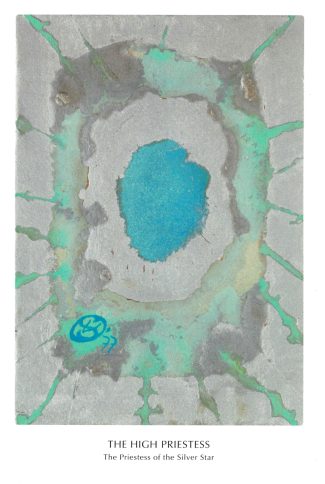Tarot cards evolved in Europe during the 14th century as a game. There is some evidence that similar cards were used earlier. A few researchers note that the images for the Trumps are more typical of the 11th or 12th century than later. While unclear who selected the images, the iconography is drawn from the Church, the Court, and common stories at the time.
Playing cards arrived in Europe from China and the Middle East. Before printing was established, the cards were individually painted, as with the Visconti Sforza deck from the 15th century. These cards tend to follow an emerging convention of standard images, although not always.
The Visconti Sforza deck is one of the oldest packs, with different cards held by different museums. Below is an early image of The Magician. According to Michael Pearce, he is dressed as an Italian scholar wearing red apparel and has the typical writing tools of the day spread across the table. Michael Dummett describes him as le bateleur, a mountebank or juggler, with his wares on the table (The Visconti-Sforza Tarot Cards, 1986, p 102). The similarities between the Visconti Sforza card and the later Jean Noblet Magician card are obvious.
As playing cards became increasingly popular, a standard set of cards still in use today emerged in Europe, with Marseilles in southern France becoming a significant center for their production. The cards were printed using woodblocks (pear, apple, pine), cut to size, then if colored, stencils were used. The process followed how holy cards depicting saints were printed.
The Tarot deck combines two sets of cards: the 22 “trump” cards and one card, a Fool; and the “playing” cards, consisting of 4 sets of “pip” cards (1 – 10) and court cards (king, queen, knight, page), for a total of 78 cards. These were used to play a card game like Bridge called tarrochio.
When condemned by authorities, their use as a game were lumped together with other games (bowling, for example) or gambling related activities, beginning in the 14th century.
A study that provides an endorsement by a Catholic leader is Meditations on the Tarot: A Journey into Christian Hermeticism. First published as anonymous, the author’s name emerged after his death: the Estonian- Russian Christian mystic Valentin Tomberg. (1900-1973). The work ends with a commentary by Cardinal Hans Urs von Balthasar supporting the work on the Tarot and Hermetic Christianity.
Wilfried Houdouin, French graphic designer and author, writes: “the so-called Marseille Tarot does not impose or require in the first place any specific cultural prerequisite, not even a particular type of education. By virtue of its archetypal nature, it addresses what is at the heart of each of us: our very evolutionary code, which proceeds from archetypal, noumenal powers, which transcend the material, phenomenal manifestation, but which are underlying all facets of humanity, and of the Great Cosmic Jewel (keeping in mind the “Jewel Theory” of Nima Arkani-Hamed who geometrically reformulates the quantum fields’ theory) sparkling with its infinite nuances, playing with the fluidity of shadows and lights on the great cosmic tapestry.” (Tarot of Marseilles – The Fundamentals: The Fundamentals of History, Symbolism, and Practice of the Philosopher’s Tarot, 2021.)
The images that came to be considered archetypes have broad and specific associations. Extensive study of the Marseille Tarot in the 20th and 21st century has led a greater understanding of the cards evolution and to a variety of interpretations of their origin.


Ace of Cups and Ace of Swords, from Tarot of Marseilles Millennium Edition, Wilfried Houdouin, 2022. Houdouin applies extensive research and the practice of sacred geometry to create beautiful cards in the Marseille tradition. Copyright Wilfried Houdouin. Used with permission. An excellent version of the deck has recently been published.
Below, the High Priestess Card created by British surrealist Ithell Colquhoun and published by Fulgur Press.





Pierpoint Morgan Visconti Sforza Tarocchi Deck, U.S. Games Systems, 1975-2007. Tarot images used with permission of U.S. Games Systems, Inc., Stamford, CT 06902. c. by U.S. Games Systems, Inc. All rights reserved.
The Torah in the Tarot, Stav Appel, Forgotten Secrets, 2019 (Major Arcana, reproduction of Jean Noblet’s cards). Copyright Stav Appel. Used with permission.
Jean Noblet Tarot de Marseille, Recreation of one of the oldest Tarot decks by Jean Noblet around 1650. William Rader and Krisztin Kondor, Artisan Tarot, 2022. (artisantarot.com). Used with permission.
Jean Noblet Tarot de Marseille, Recreation of one of the oldest Tarot decks by Jean Noblet around 1650. William Rader and Krisztin Kondor, Artisan Tarot, 2022.(artisantarot.com). Used with permission.
“If you have experienced the tarot, you know that it moves you, it moves you in the same sense that if you get into a church or a cathedral, you feel moved. Even if you were not religious, even if you don’t believe in God. So my suspicion is that the wisdom that is being passed on in the tarot is craftsmanship.”